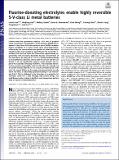Fluorine-donating electrolytes enable highly reversible 5-V-class Li metal batteries
Author(s)
Suo, Liumin; Xue, Weijiang; Gobet, Mallory; Greenbaum, Steve G.; Wang, Chao; Chen, Yuming; Yang, Wanlu; Li, Yangxing; Li, Ju; ... Show more Show less
Download1156.full.pdf (1.012Mb)
PUBLISHER_POLICY
Publisher Policy
Article is made available in accordance with the publisher's policy and may be subject to US copyright law. Please refer to the publisher's site for terms of use.
Terms of use
Metadata
Show full item recordAbstract
Lithium metal has gravimetric capacity ∼10× that of graphite which incentivizes rechargeable Li metal batteries (RLMB) development. A key factor that limits practical use of RLMB is morphological instability of Li metal anode upon electrodeposition, reflected by the uncontrolled area growth of solid-electrolyte interphase that traps cyclable Li, quantified by the Coulombic inefficiency (CI). Here we show that CI decreases approximately exponentially with increasing donatable fluorine concentration of the electrolyte. By using up to 7 m of Li bis(fluorosulfonyl)imide in fluoroethylene carbonate, where both the solvent and the salt donate F, we can significantly suppress anode porosity and improve the Coulombic efficiency to 99.64%. The electrolyte demonstrates excellent compatibility with 5-V LiNi0.5Mn1.5O4cathode and Al current collector beyond 5 V. As a result, an RLMB full cell with only 1.4× excess lithium as the anode was demonstrated to cycle above 130 times, at industrially significant loading of 1.83 mAh/cm2and 0.36 C. This is attributed to the formation of a protective LiF nanolayer, which has a wide bandgap, high surface energy, and small Burgers vector, making it ductile at room temperature and less likely to rupture in electrodeposition.
Date issued
2018-01Department
Massachusetts Institute of Technology. Department of Materials Science and Engineering; Massachusetts Institute of Technology. Department of Nuclear Science and EngineeringJournal
Proceedings of the National Academy of Sciences
Publisher
National Academy of Sciences (U.S.)
Citation
Suo, Liumin et al. “Fluorine-Donating Electrolytes Enable Highly Reversible 5-V-Class Li Metal Batteries.” Proceedings of the National Academy of Sciences 115, 6 (January 2018): 1156–1161 © 2018 National Academy of Sciences
Version: Final published version
ISSN
0027-8424
1091-6490